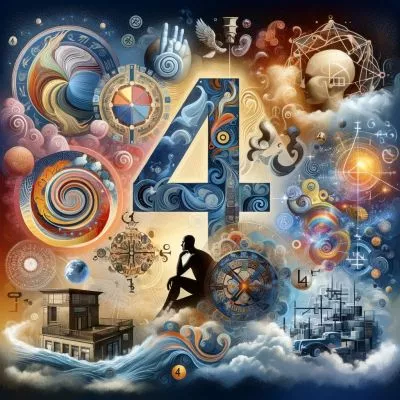Dancing with Shadows: A Deep Dive into Nightmare Dream Meanings

Explore the enigmatic realm of nightmare dream meanings, where fear meets symbolism. Delve into the layers of the subconscious, deciphering the cryptic messages masked as terrifying nocturnal visions. Understanding these daunting dreams can shed light on suppressed emotions, paving the path toward emotional resolution.
I. Introduction: The Enigmatic Universe of Nightmare Dream Meanings
A. A Journey into the Labyrinth of Nightmares and Dreams
Dreams, these mysterious narratives spun by our subconscious minds during sleep, can often bewilder and intrigue us. They range from pleasant visions to unnerving nightmares, each carrying a distinct essence and meaning. Nightmares, specifically, are intense, disturbing dreams that invoke emotions of fear, anxiety, and distress. They are not merely tormenting dreams but an intricate tapestry of deep-seated emotions and experiences. They often jolt us awake, leaving residual traces of dread that may linger. However, nightmares are not simply the mind’s way of tormenting us during our vulnerable sleeping hours. They are windows into our subconscious, holding cryptic messages waiting to be deciphered.
B. The Paramount Role of Nightmare Decoding
Interpreting nightmares is no less important than understanding dreams of a lighter nature. Despite their disturbing nature, nightmares carry invaluable insights into our inner emotional state, suppressed fears, unresolved issues, and, sometimes, our deepest desires. They can unmask latent fears and unresolved emotional conflicts that we might be oblivious to in our waking life. While they may stir distress, understanding and interpreting these night-time terrors can lead to deeper self-awareness, emotional healing, and personal growth. By interpreting these nightmares, we can navigate our internal emotional labyrinth, identifying and addressing issues hindering our mental well-being. Indeed, understanding the meaning behind our nightmares is not a journey for the faint-hearted but a rewarding one for those daring to face their subconscious fears head-on.
II. Understanding the Language of Dreams
A. The Cryptic Symbols of Nightmares
Nightmares speak a language of their own – a language of symbolism. Every element in the nightmare, whether characters, objects, or scenarios, symbolizes a certain aspect of our inner world. Symbolism in nightmares can be complex and multilayered, often reflecting our deepest fears, unresolved issues, and even past traumas. The settings of our nightmares, the people we encounter, and our actions all carry a deeper, symbolic meaning. For instance, a frightening creature in a nightmare may symbolize an intimidating situation or person in our waking life. Understanding these symbols is key to unraveling the meaning behind our nightmares.
B. The Tangled Web of Conscious and Subconscious Minds
The realm of nightmares is a playground for the subconscious mind. It is where our conscious mind’s logical barriers are lowered, and the subconscious mind roams free. Our subconscious mind uses this freedom to communicate with us through symbols and scenarios that might seem absurd or terrifying to our conscious mind. The conscious mind attempts to make sense of our world through logic and reason, while the subconscious mind communicates through emotions, images, and symbols. These two parts of our psyche are intertwined during dreaming, leading to the manifestation of nightmares.
III. Common Nightmare Themes and Their Interpretations
A. The Abyss Below: Falling or Drowning
Falling or drowning nightmares often signify insecurity, loss of control, or overwhelming emotions. Falling may indicate a sense of failure or an impending fear of not meeting expectations. Drowning could symbolize feeling overwhelmed by emotions or situations. It might represent our struggle to stay afloat amidst life’s challenges.
B. The Chase: Pursued by Fear
Being chased in a nightmare is another common theme and usually suggests that the dreamer avoids something in waking life. The pursuer often represents a problem, fear, or aspect of oneself that the dreamer tries to evade. The nature of the pursuer and the emotions evoked during the chase can provide further insight into the issue being avoided.
C. The Inevitable End: Death or Loss
While distressing, dreams of death or loss often symbolize endings and new beginnings rather than literal death. They signify the end of a phase, relationship, or a part of oneself. Alternatively, they could highlight deep-seated fears of abandonment, change, or the unknown. Understanding the context and emotions of these dreams is crucial for their interpretation.
IV. Psychological Perspective on Nightmares
A. The Shadows of the Past: Nightmares and Trauma
From a psychological standpoint, nightmares can often be the subconscious’s response to trauma. Traumatic events can deeply impact the psyche, leading to a profound emotional disturbance. These traumatic experiences, particularly those not adequately addressed or processed, can resurface as terrifying nightmares, causing further distress. This phenomenon, often seen in Post Traumatic Stress Disorder (PTSD), is the mind’s attempt to cope with and process the trauma. Understanding and addressing the source of the trauma is crucial to alleviate these recurring nightmares.
B. The Manifestation of Unease: Anxiety and Stress Reflected in Nightmares
Nightmares can also be a manifestation of anxiety and stress. High stress or anxiety levels in waking life can transgress into our dream world, creating horrifying nightmares. These nightmares can reflect our anxieties about personal issues, work stress, or fear of the future, providing an unfiltered view into our worry-laden subconscious mind. Recognizing and managing these stressors can significantly reduce the frequency and intensity of such nightmares.
V. The Role of Culture and Personal Experiences in Nightmare Interpretation
A. Through the Cultural Prism: Variations in Nightmare Symbols
Culture can significantly influence our nightmares and their interpretation. Symbolism in nightmares is not universal; what might be terrifying in one culture could be benign or even positive in another. Cultural beliefs, traditions, and societal fears can shape the symbols our subconscious employs in nightmares. For example, in Western culture, snakes in dreams might be seen as a symbol of deceit or danger, whereas in Eastern cultures, they can symbolize wisdom or transformation. Hence, interpreting nightmares through the lens of one’s cultural background can provide a more accurate understanding.
B. The Personal Unconscious: Individual Experiences and Nightmare Meanings
Alongside culture, personal experiences significantly influence nightmare themes and interpretations. The subconscious mind draws from our history, including past events, relationships, successes, and failures, to create dream scenarios. Each individual’s nightmares are unique to their experiences and emotional state. For example, someone with a history of abandonment might frequently dream of being left alone in threatening situations. Therefore, it’s important to consider personal experiences and individual psychological makeup when interpreting nightmare meanings.
VI. How to Handle Recurring Nightmares
A. Mastering the Shadows: Techniques for Controlling Nightmares
Recurring nightmares can significantly disrupt sleep and negatively impact daily life. However, various techniques can help control and even transform these terrifying dreams. Journaling can effectively record and reflect on nightmare content, helping to decode its meaning. Some people find relief through meditation and relaxation before bed, which can lower stress levels and promote peaceful sleep. Another approach is ‘imagery rehearsal therapy,’ where the individual visualizes the nightmare and consciously alters its outcome. This technique can be particularly useful for trauma-related nightmares.
B. The Path to Healing: Seeking Professional Help for Persistent Night Terrors
If nightmares persist, disrupt sleep, or cause significant distress, it may be beneficial to seek professional help. Therapists and psychologists are trained to assist in understanding and processing the issues underlying these dreams. For example, cognitive-behavioral therapy effectively reduces nightmare frequency and distress. Remember that seeking help is a sign of strength, and the first step towards improved mental well-being is crucial.
FAQs
Q: What does it mean if I keep having nightmares?
A: Frequent nightmares can indicate high levels of stress, unresolved emotional issues, or even past traumas. However, the specific meanings are unique to the individual and depend on the content of the nightmares.
Q: Can nightmares predict the future?
A: While some cultures and traditions may attribute prophetic powers to dreams, from a psychological standpoint, nightmares reflect our current emotional state and past experiences rather than future predictions.
Q: How can I stop having nightmares?
A: Stress management, relaxation exercises before sleep, maintaining a healthy sleep routine, and imagery rehearsal therapy can help reduce nightmares. If they persist, consider seeking professional help.
Q: Why do I dream of being chased or falling?
A: Dreams of being chased often symbolize evasion of a problem or fear in waking life. Falling, on the other hand, can reflect feelings of insecurity or fear of failing.
Q: Does everyone experience nightmares?
A: Yes, most people experience nightmares at some point. However, the frequency and intensity of nightmares can vary from person to person.
Q: Can certain foods or medications cause nightmares?
A: Some research suggests that certain foods, medications, or substances like alcohol and caffeine can influence dream content and potentially lead to nightmares. However, this varies significantly among individuals.
Q: How can culture influence nightmare meanings?
A: Culture can shape the symbols and scenarios our subconscious uses in nightmares. It influences our fears, beliefs, and perceptions, reflected in our dreams. Therefore, considering cultural background can aid in accurate nightmare interpretation.
Conclusion
A. The Unseen Significance of Nightmare Understanding
Understanding the meaning behind our nightmares is like exploring a shadowy labyrinth within our psyche. It may appear daunting, but it is a journey of immense significance. Each terrifying vision, every alarming symbol, holds the potential to enlighten us about our deepest fears, hidden anxieties, and unresolved issues. They are our subconscious mind’s call to attention, asking us to face and resolve the emotional disturbances we might overlook in our waking life. By understanding our nightmares, we gain a deeper awareness of our emotional health and psychological well-being.
B. Empowerment through Nightmare Deciphering
Decoding nightmares is more than a process of psychological exploration; it is a pathway to empowerment. When we comprehend our nightmares, we seize control over the fear they induce. We learn to transform these terrifying visions from sources of dread to tools of introspection and personal growth. The understanding and insight we gain allow us to face our suppressed fears and anxiety, fostering resilience, self-awareness, and emotional equilibrium. Unraveling the secrets of nightmare dream meanings, thus, is an empowering journey towards self-understanding and emotional healing.
Suggested Readings
To further delve into the fascinating world of nightmare dream meanings, several enriching resources are available. Here are some recommended books that shed light on the mysterious realm of dreams and nightmares:
- “The Interpretation of Nightmares: A Journey into the Depths of the Subconscious” – A comprehensive guide that offers a deep dive into the psychological aspects of nightmares, their symbolic language, and methods for interpretation.
- “Dreamland: A Comprehensive Guide to Nightmare Symbols and Their Meanings” provides an extensive catalog of nightmare symbols and potential interpretations based on psychological and cultural perspectives.
- “Shadow Visions: Understanding and Overcoming Nightmares” – A helpful resource for those struggling with recurring nightmares, offering practical strategies for understanding and controlling these nocturnal disturbances.
- “The Night Terror Handbook: From Fear to Freedom” – A manual offering psychological insights into the causes of nightmares and practical techniques for transforming night terrors into sources of personal growth.
- “In the Realm of Dreams: A Cross-cultural Exploration of Nightmare Meanings” – A compelling read that explores how cultural variations impact the symbolism and interpretation of nightmares.
Unraveling the mysteries of nightmares is a deeply personal and transformative journey. These books offer a guiding light, helping you decode your subconscious mind’s cryptic messages hidden within the haunting realms of nightmares.






